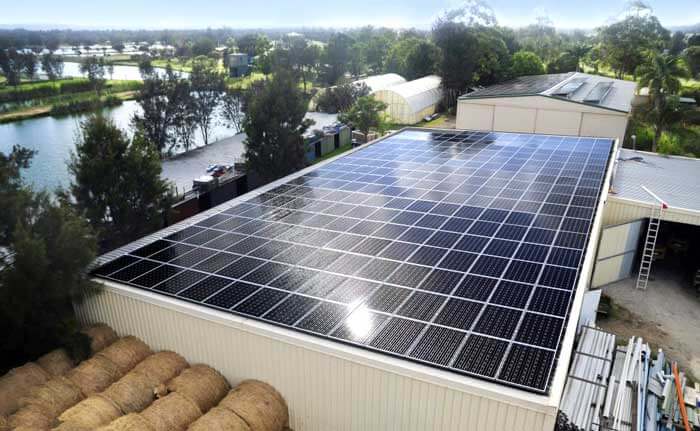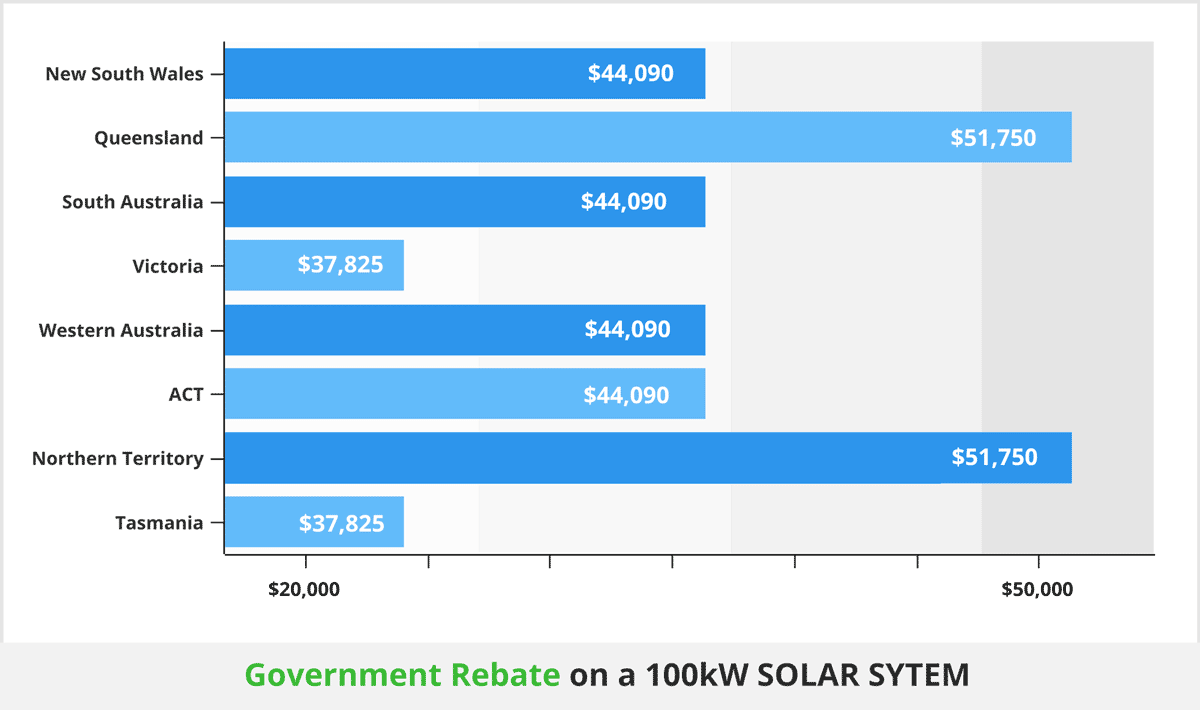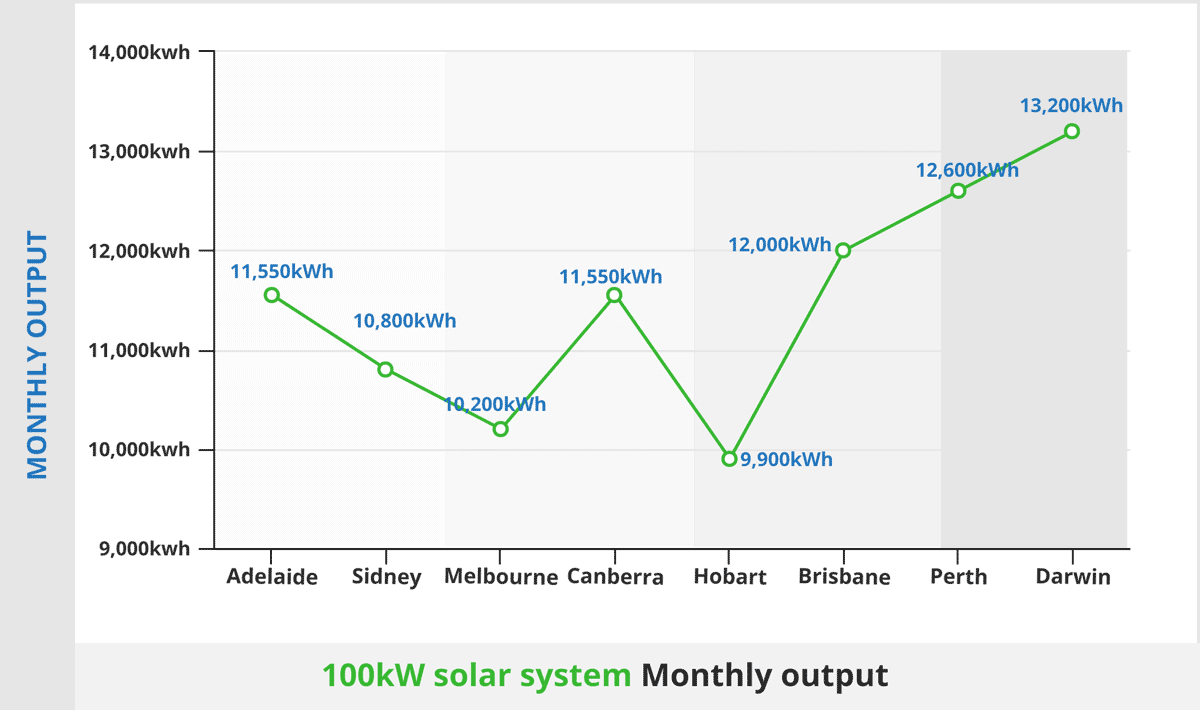Home Commercial Solar 100kW Commercial Solar System Cost
100kW Commercial Solar System Cost
Businesses that are medium to large in size and considering a switch to solar power will find the 100kW commercial system a top pick in the Australian market. Thanks to its significant size, this setup produces a considerable amount of power, markedly slashing your electricity costs and lessening your ecological footprint.
On average, the 100kW commercial solar system will cost around $81,919, including government rebates and taxes. The actual cost will depend on the installer you choose and your location in the country.
Besides its energy generation potential, this system is widely popular because it’s the cut-off size for the Australian government rebates.
Table of Contents
ToggleGovernment Rebate for 100kW solar system

The Australian government runs an incentive program that allows solar owners to receive up-front discounts on their solar systems. This is part of their Small-scale Renewable Energy Scheme that aims at encouraging more Australians to adopt renewable energy sources.
As mentioned, the 100kW solar system is the cut-off point for this federal rebate program. To receive the rebates, you’ll have to claim your small-scale technology certificates (STCs) – which are tradable certificates you exchange for a point-of-sale discount on your solar system.
The number of STCs you receive then determines how much rebate you can receive. Commercial solar systems, like the 100kW, tend to receive more rebates since they generate more power than residential solar systems.
Some states also receive more rebates than others for the same size solar system. This is because the government gives more STCs to states with higher sunlight intensities.
Here’s a quick look at how much rebate you can expect for your 100kW commercial system by the state.
| State | System Size | Zone | Zone rating | Rebate |
|---|---|---|---|---|
| New South Wales | 100kW | 3 | 1.382 | $38,003 |
| Queensland | 100kW | 1 | 1.622 | $44,606 |
| South Australia | 100kW | 3 | 1.382 | $38,003 |
| Victoria | 100kW | 4 | 1.185 | $32,580 |
| Western Australia | 100kW | 3 | 1.382 | $38,003 |
| ACT | 100kW | 3 | 1.382 | $38,003 |
| Northern Territory | 100kW | 1 - 2 | 1.536 | $42,248 |
| Tasmania | 100kW | 4 | 1.185 | $32,580 |
rebate decrement until it’s completely phased out.
Aside from the government rebates, some state governments also offer rebates for residential and commercial solar. If you’re in Victoria, New South Wales, Western Australia, Queensland or South Australia, you might as well complement the federal rebate with a state rebate.
However, some state rebate programs don’t cover up to 100kW solar systems, so ensure you check your state’s requirements before applying.
What's the Feed-in tariff for a 100kW solar system
With businesses spending most of their energy during the day, going solar does a great deal at offsetting their power bills. The feed-in tariff scheme provides another way to maximize your solar system.
Through this program, businesses get to resell any excess energy generated by their solar system back to the national grid. This comes in handy if you don’t have a solar battery, or during weekends and holidays when the business energy consumption is low.
When you send your energy back to the grid, your energy company pays for the extra kilowatts. This could be in the form of net feed-in where they account for it in your bills, or through gross metering.
To qualify for this program, all you have to do is ensure that your 100kW commercial solar system meets your energy company’s requirements.
The amount of income you will receive from this tariff will depend on the rates offered by your energy supplier and your state. These utility rates will also differ depending on the time of day.
During peak hours, the utility rates are usually the highest, and lowest during the shoulder and off-peak periods.
Here’s an idea of the best feed-in rates across different states.
| Company | 1st Company (Average Rate) – c/kWh | 2nd Company (Average Rate) – c/kWh | 3rd Company (Average Rate) – c/kWh |
|---|---|---|---|
| NSW | Origin Energy – 16.5 | AGL – 15.55 | Mojo Power – 15.0 |
| VIC | Origin – 17.0 | AGL – 15.65 | DC Power Co – 15.0 |
| QLD | Energy Australia – 16.15 | AGL – 15.3 | DC Power Co – 15.0 |
| SA | AGL – 18.15 | Origin Energy – 16.5 | Power Direct – 16.3 |
| ACT | Origin Energy – 14.0 | Energy local – 12.5 | Energy Australia – 12.5 |
| WA | Horizon – 30.0 | Synergy – 7.2 | N/A |
| NT | Jacana Energy – 23.6 | Power water corporation – 19.23 | N/A |
As you can see above, the feed-in rates are quite low compared to the cost of electricity in the country. Therefore, you can’t depend on this program to get the most out of your 100kW system.
Consuming the most power is still the best way to increase the ROI of your solar system. The feed-in tariff is just icing on the cake.
What's the payback period on 100kW solar?
Usually, anywhere between 3 and 5 years. There are numerous factors that determine how fast your 100kW commercial solar system can pay for itself. The most important include your energy consumption and your location.
Your location determines how much sunlight your solar system receives. This, in turn, determines how much rebate you receive for your 100kW solar system, and hence, its overall price.
Keep in mind; Calculating your payback means dividing the total cost of your solar system by how much you can save annually. The more expensive the system is, the longer it might take to pay back.
Your energy consumption is also crucial in determining how fast the system can pay itself. The more energy you consume during the day, the faster the solar system pays for itself.
Thankfully, most businesses spend most of their power during the daytime. This results in immense savings in power costs and faster payback.
Number of panels needed for 100KW
Most 100kW commercial solar systems need between 330 – 400 solar panels. The actual number depends on the power ratings of the solar panels you’re using. For instance,
If you’re using 250W solar panels, you’ll require: 100,000 / 250W = 400 panels.
If you’re using 275W solar panels, you’ll require: 100,000 / 275W = 364 panels.
If you’re using 300W solar panels, you’ll require: 100,000 / 300W = 334 panels.
The lower the power rating of the solar panels you use, the more the panels you’ll need. For commercial businesses with limited roof space, panels rated 330W and 350W can mean you only need 304 and 286 panels respectively!

Roof space is needed for 100kW solar
The total roof space you’ll need will depend on the size and number of solar panels you use. Most manufacturers use a standard size,1.7m x 1m, for their panels, meaning each panel occupies 1.7m2 on your roof.
Therefore, for 350 – 400 solar panels, you’ll need approximately 595m2 – 680m2.
You’ll also need to account for your roof’s shape and orientation and any components mounted on the roof.
A good practice would be to consult with an expert to help with the sizing.
Battery size for 100kW’s
Once your 100kW commercial solar system is running, installing a solar battery can drastically improve the system’s ROI. The battery allows you to store the free solar energy for later use instead of relying on power from the grid and the feed-in tariffs.
However, most businesses fear going for solar batteries because of their high costs. What they don’t know is that commercial solar systems don’t require massive batteries. The solar battery size for your solar system might be similar to that of a residential system or even smaller.
This is because commercial businesses utilize around 70% of their power during the day, leaving only 30% of the generated power for the battery or sending it back to the grid.
Residential systems, on the other hand, need large batteries because they spend around 70% of their power at night.
Therefore, with most businesses consuming an average of 350kWh, your 100kW solar system only requires a 105kWh battery.
However, if you’re going completely off-grid, you might need a bigger solar battery that meets your daily energy consumption demands.
Are the solar batteries worth it?
Well, it depends. Different commercial businesses have different energy needs. For a business that requires constant power for its operations, solar batteries might be worth it. The batteries will provide a good backup.
However, for regular businesses working during the day, the high cost of solar batteries might not be worth it. Adding a battery increases not only the cost but also the overall payback period of your solar system.
It would actually be cheaper to channel the surplus power back to the grid or invest that money in a bigger solar system.
100kW solar inverter for commercial solar
With inverters for commercial solar systems, you want to ensure that they are almost the same size (in watts) as your solar system. So, your 100kW solar system should have a 100,000W solar inverter.
You’ll have to choose between String inverters, Microinverters or central inverters. Microinverters are the most efficient but are quite pricey. If your budget is tight, most installers lean towards multiple small-sized string inverters for commercial buildings over large central inverters.
Factors such as your location and the inverter’s design will, however, influence the size of the inverter you should install.
If you live in a sunny area, you’ll need an inverter that’s almost as big as your solar system or slightly bigger. This will help accommodate the amount of energy your system produces.
If you live in a cooler area, a smaller inverter than the system size might be ideal since the system generates less power.
Similarly, the design of your solar system influences the inverter size you’ll need. North-facing panels generate a lot of energy and hence, require a similar-sized inverter. Panels facing other directions may require a smaller inverter.
The shading conditions of your solar panels will also determine your system’s inverter size.
Keep in mind; The inverter is an extremely important component of your solar system. You should therefore consult an expert before settling on the size you’ll need for your 100kW commercial system.
Daily output of a 100kW solar panel system
The 100kW commercial solar system generates an average of 400kWh daily. The real range is between 360kWh and 440kWh depending on your location.
Solar systems in cities like Brisbane, Perth, Darwin, and Canberra generally generate more power compared to those in Sydney and Melbourne. This is because these areas receive higher solar intensities.
Other factors that affect the output of solar panels include their tilt angle, orientation, and time of year.
Solar panels in the southern hemisphere produce more power when facing the North. Panels tilted at least 30o also tend to produce more power than panels on flat roofs.

Monthly output of a 100kW solar system
The average 100kW solar system generates around 12,000kWh. This output still differs depending on your location and the time of the year.
Your solar system generates more power during the summer months, October – April, and significantly lower during winter. This is because the days are much longer during summer and shorter during winter.
Here’s an overview of how much power you can expect per month from your 100kW commercial solar system.
| City | Monthly output |
|---|---|
| Adelaide | 11,550kWh |
| Sidney | 10,800kWh |
| Melbourne | 10,200kWh |
| Canberra | 11,550kWh |
| Hobart | 9,900kWh |
| Brisbane | 12,000kWh |
| Perth | 12,600kWh |
| Darwin | 13,200kWh |
How much money will I save with a 100kW system?
With such a high daily power output, you can save anywhere from $20,000 to $50,000+ every year. It will all depend on how much power your business consumes daily.
Generally, businesses that consume more of their generated energy have reported higher savings. You’ll also earn more savings depending on the cost of electricity in your area.
Higher electricity costs mean you’re not spending a lot of money on electricity from the grid.
Here’s how you can calculate your savings with a 100kW solar system.
Assuming that you’re living in Sydney where electricity costs 32c/kWh, with a monthly solar power output of 10,800kWh. If you consume 70% of your generated power, you’ll be consuming 7,560kWh.
In savings, this translates to around $2,419.20. Annually, this is around $29,030.40, excluding any income from the feed-in tariffs. When you include feed-in tariffs, you easily save more than $30,000 each year.
This gives your solar system slightly over 3 years in its payback period.
If you install a solar battery, you further increase your savings since your reliance on the grid electricity will be lower.
FAQs
How big is a 100kW solar system?
Around 700 square meters. The 100kW commercial solar system is one of the biggest systems in the Australian market today. It incorporates around 400 solar panels, about 4 inverters and generates more than 12,000kWh monthly.
Are commercial solar systems worth it?
Yes! Investing in solar panels for businesses can really help cut down their energy costs and boost their profits. Going solar is particularly beneficial for businesses in areas with high electricity costs and high sunlight intensities.
There are also other benefits of solar, like helping save the environment and improving your property’s market value.
Are solar panels bad for your roof?
No! Solar panels will not destroy your roof unless the roof is in a poor condition, or when installed by an inexperienced installer. Always go for an accredited solar installer when installing your solar panels.
Does the government offer incentives for my solar system?
Yes! Both the federal government and some state governments offer generous incentive programs to bring down solar costs. These rebates can cover up to 50% of your total solar cost. Read here to find out more about the program and whether you qualify for it.
Compare Solar Panel Quotes
Table of Contents
Toggle











